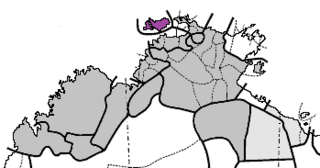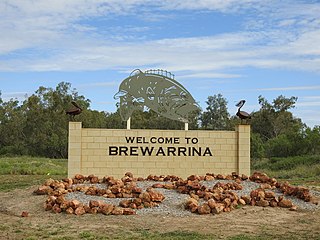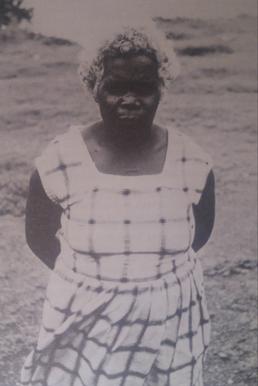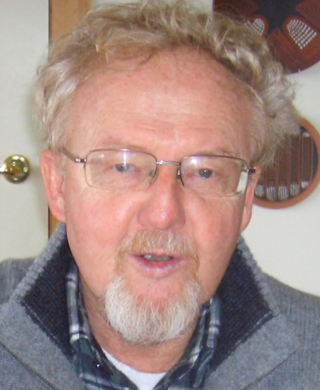Related Research Articles
In Australian Aboriginal religion and mythology, Binbeal is a spirit associated with rainbows. He is a son of Bunjil.
In Murrinh-Patha mythology, Nogamain is a god who gives spirit children to mortal parents. He created himself from nothingness.

The 2004 Redfern riots took place on the evening of Sunday 15 February 2004, in the inner Sydney suburb of Redfern, New South Wales, and were sparked by the death of 17-year-old Thomas Hickey, also known as TJ Hickey, resulting from a bike accident in the neighbouring suburb of Waterloo on 14 February 2004.

Crime in Australia is managed by various law enforcement bodies, the federal and state-based criminal justice systems and state-based correctional services.

Tiwi is an Australian Aboriginal language spoken by the Tiwi people on the Tiwi Islands, within sight of the coast of northern Australia. It is one of about 10% of Australian languages still being frequently learned by children.

Aboriginal deaths in custody is a political and social issue in Australia. It rose in prominence in the early 1980s, with Aboriginal activists campaigning following the death of 16-year-old John Peter Pat in 1983. Subsequent deaths in custody, considered suspicious by families of the deceased, culminated in the 1987 Royal Commission into Aboriginal Deaths in Custody (RCIADIC).

Brewarrina is a town in north-west New South Wales, Australia on the banks of the Barwon River in Brewarrina Shire. The name Brewarrina is derived from 'burru waranha', a Weilwan name for a species of Acacia, Cassia tree, "Acacia clumps", "a native standing" or "place where wild gooseberry grows". It is 96 kilometres (60 mi) east of Bourke and west of Walgett on the Kamilaroi Highway, and 787km from Sydney. The population of Brewarrina in 2016 was 1,143. Other towns and villages in the Brewarrina district include: Goodooga, Gongolgon, Weilmoringle and Angledool.

The Dharug language, also spelt Darug, Dharuk, and other variants, and also known as the Sydney language, Gadigal language, is an Australian Aboriginal language of the Yuin–Kuric group that was traditionally spoken in the region of Sydney, New South Wales, until it became extinct due to effects of colonisation. It is the traditional language of the Dharug people. The Dharug population has greatly diminished since the onset of colonisation. Eora language has sometimes been used to distinguish a coastal dialect from hinterland dialects, but there is no evidence that Aboriginal peoples ever used this term, which simply means "people". Some effort has been put into reviving a reconstructed form of the language.
William Leonard Gammage is an Australian academic historian, adjunct professor and senior research fellow at the Humanities Research Centre of the Australian National University (ANU). Gammage was born in Orange, New South Wales, went to Wagga Wagga High School and then to ANU. He was on the faculty of the University of Papua New Guinea and the University of Adelaide. He is a fellow of the Australian Academy of Social Sciences and deputy chair of the National Museum of Australia.
The 2004 Palm Island death in custody incident relates to the death of an Aboriginal resident of Palm Island, Cameron Doomadgee on Friday, 19 November 2004 in a police cell. The death of Mulrunji led to civic disturbances on the island and a legal, political and media sensation that continued for fourteen years.

Smoking ceremony is an ancient and contemporary custom among some Aboriginal Australians that involves smouldering native plants to produce smoke. This herbal smoke is believed to have both spiritual and physical cleansing properties, as well as the ability to ward off bad spirits. In traditional, spiritual culture, smoking ceremonies have been performed following either childbirth or initiation rites involving circumcision. In contemporary culture, elements of smoking ceremonies have been incorporated into Welcome to Country performances and other spiritual events held for the general public.
Media portrayals of Indigenous Australians have been described by academics and commentators as often negative or stereotyped. It is said that in issues which concern them, the voices of Indigenous Australians are drowned out by non-Indigenous voices, which present them as problems for the rest of society.
Corrective Services New South Wales (CSNSW) is a division of the Department of Communities and Justice of the Government of New South Wales, Australia. CSNSW is responsible for the state's prisons and a range of programs for managing offenders in the community. The state has 36 prisons, 33 run by CSNSW and three privately operated. The agency traces its origins back to 1788, when New South Wales was founded as a penal colony.

Catherine Helen Berndt, néeWebb was a New Zealand-born Australian anthropologist known for her research in Australia and Papua New Guinea conducted jointly with her husband, Ronald Berndt.
In the anthropological study of kinship, a moiety is a descent group that coexists with only one other descent group within a society. In such cases, the community usually has unilineal descent so that any individual belongs to one of the two moiety groups by birth, and all marriages take place between members of opposite moieties. It is an exogamous clan system with only two clans.
Indigenous Australians are both convicted of crimes and imprisoned at a disproportionately higher rate in Australia, as well as being over-represented as victims of crime. As of September 2019, Aboriginal and Torres Strait Islander prisoners represented 28% of the total adult prisoner population, while accounting for 2% of the general adult population. Various explanations have been given for this over-representation, both historical and more recent. Federal and state governments and Indigenous groups have responded with various analyses, programs and measures.
Charles Dunford Rowley was an Australian public servant and academic.

Mondalmi was an Aboriginal activist and cultural informant from Australia.

Erich Kolig is an Austrian–New Zealand cultural and social anthropologist whose research has focussed on Muslim and Islamic social and religious issues, and Australian Aboriginal culture. He has written and edited 13 books, as well as publishing many scientific papers and book chapters.

A cleverman is a traditional healer and keeper of culture in many Aboriginal cultures of Australia. The roles, terms for, and abilities of a cleverman vary between different Aboriginal nations. Some clevermen heal bodily injuries and illnesses, while others heal spiritual ailments. They heal using plants, songs, and spiritual knowledge. Exceptionally powerful clevermen are believed to have magical powers and may heal both physical and spiritual ailments. Some sources also refer to clevermen having the ability to kill using magic, although this may be illegal within the culture or a separate form of harmful 'sorcery' from that used by cleverman healers. Clevermen also serve as cultural keepers and are experts in stories and spiritual beliefs. They have a strong understanding of sacred places and lore and a deep connection to the Dreaming. Clevermen may be men or women, depending on the culture.
References
- ↑ Austin-Broos, Diane (2015). "Brewarrina: An Australian Story". Oceania . 85 (2). Wiley: 238–242. doi:10.1002/ocea.5087. ISSN 0029-8077.
- ↑ Gregg Barak (1991). Crimes by the Capitalist State: An Introduction to State Criminality. SUNY Press. pp. 27–. ISBN 978-0-7914-0584-0.
- ↑ Morris, Barry (2001). "Policing Racial Fantasy in the Far West of New South Wales". Oceania . 71 (3). Wiley: 242–262. doi:10.1002/j.1834-4461.2001.tb02751.x. hdl: 1959.13/27052 . ISSN 0029-8077. JSTOR 40331803.
- ↑ "Royal Commission into Aboriginal Deaths in Custody: Inquiry". The Age of Enquiry. La Trobe University. 2020. Retrieved 1 July 2021.
- 1 2 Pitty, R. (October 1994). "Brewarrina riot: The hidden history". Aboriginal Law Bulletin . 3 (70): 9–11. ISSN 0728-5671 – via Informit.
- 1 2 Morris, Barry (2005). "A Crisis in Identity". Critique of Anthropology. 25 (1). SAGE Publications: 59–85. doi:10.1177/0308275x05048613. ISSN 0308-275X. S2CID 145060422.